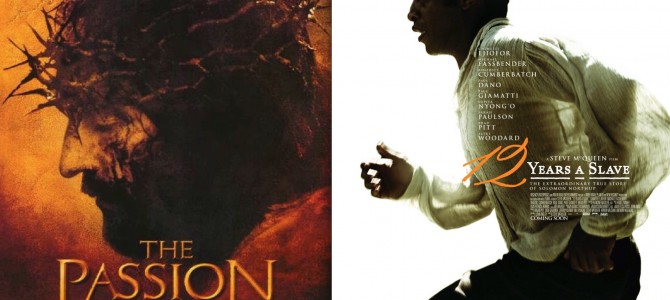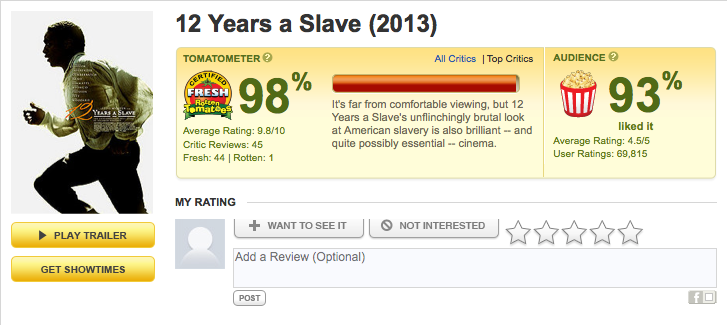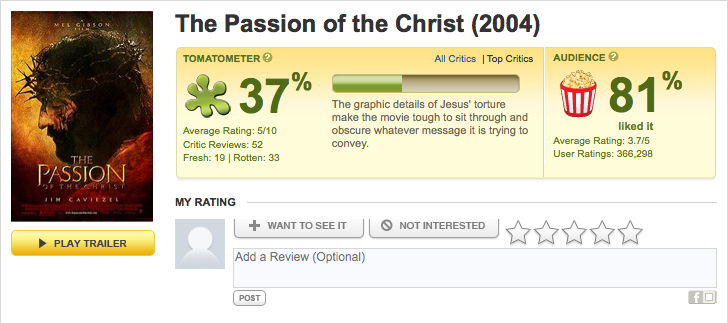
The film “12 Years A Slave” was easily the critics’ favorite last year. It just won the Golden Globe for Best Drama and will surely be nominated for and win many more awards. On Rotten Tomatoes, which aggregates film reviews, the film has positive reviews from 93 percent of viewers and a whopping 98 percent of top critics. It’s not just that it’s good but that there is so little bad in it. If you have a strong enough stomach for visual depictions of unspeakably brutal violence, you likely will not regret seeing this movie. The source material, a memoir of one man’s enslavement, is straightforward. The acting is great.
So don’t let the bullying from progressive critics or the lame protests from the professionally outraged dissuade you from seeing the film. To judge from box office receipts, people have been dissuaded. Or, at least, the film is not being seen by many. While someone at Salon thought the movie was “one of the most popular” of last year, that was not true. It was actually ranked 75th. As Jonathan Last pointed out, that means it was less popular than “42,” “The Smurfs 2,” “Jurassic Park 3D” and “A Haunted House.”
But the critical reception of the film also demonstrates a dramatic change in critics’ appreciation for violence in movies. When my husband and I viewed the movie, I found it almost unbearable to watch. It reminded me of my response to “The Passion of the Christ,” the visceral 2004 film about the suffering and death of Jesus. Both films are very good. Both films are depictions of real people in history. Both films are full not just of violence but violence that must be depicted because it serves the central point. And both films deal profoundly with the effects of human sinfulness.
Perhaps you’ll be as intrigued as I was in seeing the difference in critical reception not just for the films but also on the specific point of violence.
Here’s the Rotten Tomatoes summary for “12 Years A Slave“:

The blurb, in case you didn’t catch it: “It’s far from comfortable viewing, but 12 Years a Slave’s unflinchingly brutal look at American slavery is also brilliant — and quite possibly essential — cinema.”
Now let’s look at “The Passion of the Christ“:
 Unlike “12 Years a Slave,” “The Passion of the Christ” was wildly popular despite being in Aramaic and Latin — the third-most popular in 2004, coming in only behind the sequels in the Shrek and Spider-Man series. Its domestic receipts were more than $370 million. And even for that level of popularity, it had 81 percent positive reviews from viewers. If you look at the top-three grossing films each year since then, many don’t get that many positive reviews from viewers. Those that did — “Iron Man,” “The Dark Knight,” “Avatar,” “Toy Story 3,” “Harry Potter and the Deathly Hallows – Part 2,” “Marvel’s The Avengers,” “The Dark Knight Rises,” “The Hunger Games,” “The Hunger Games: Catching Fire,” “Despicable Me 2” — also received favorable reviews from the professional critics.
Unlike “12 Years a Slave,” “The Passion of the Christ” was wildly popular despite being in Aramaic and Latin — the third-most popular in 2004, coming in only behind the sequels in the Shrek and Spider-Man series. Its domestic receipts were more than $370 million. And even for that level of popularity, it had 81 percent positive reviews from viewers. If you look at the top-three grossing films each year since then, many don’t get that many positive reviews from viewers. Those that did — “Iron Man,” “The Dark Knight,” “Avatar,” “Toy Story 3,” “Harry Potter and the Deathly Hallows – Part 2,” “Marvel’s The Avengers,” “The Dark Knight Rises,” “The Hunger Games,” “The Hunger Games: Catching Fire,” “Despicable Me 2” — also received favorable reviews from the professional critics.
But check out that top critics rating for “The Passion of the Christ”: only 37 percent. “The Passion of the Christ” also received no major Oscar nominations. Whereas critics were much more favorable to the other hit films that year relative to the general audience (see Shrek 2 and Spider-Man 2), this was a move in the opposite direction. Dramatically in the opposite direction. And check out that blurb: “The graphic details of Jesus’ torture make the movie tough to sit through and obscure whatever message it is trying to convey.”
I went ahead and looked at what top critics had to say for both movies. The comparison and contrast is intriguing. The snippets from these reviews show the vast majority of publications and critics evolved on the violence issue. Whereas many claimed they objected to “The Passion of the Christ” on the grounds of the violence it portrayed, many critics also claimed that the violent depiction of slavery was what made “12 Years A Slave” such a great film.
San Jose Mercury News
Passion: The extreme violence does not teach a lesson; it’s an end in itself, more suited to the S&M crowd than to anyone seeking an uplifting sermon on everlasting redemption. (Glenn Lovell)
Slave: This is not medicine for America to swallow; it’s filmmaking of the highest caliber. (Randy Myers)
Detroit News (same critic)
Passion: A filmed bloodletting like no other on record, essentially a terribly graphic two-hour torture sequence. (Tom Long)
Slave: “12 Years a Slave” lays out an institution so twisted and wrong that its honest portrayal has been avoided for centuries. Yes, it’s dark and brutal. It needs to be. (Tom Long)
Boston Globe (same critic)
Passion: A profoundly medieval movie, yes. Brutal almost beyond powers of description, yes. More obsessed with capturing every holy drop of martyr’s blood and sacred gobbet of flesh than with any message of Christian love, yes. (Ty Burr)
Slave: “12 Years a Slave” isn’t the story of an American tragedy. It’s the story of the American tragedy — this country’s original sin….“12 Years a Slave” is to the “peculiar institution” what “Schindler’s List” was to the Holocaust: a work that, finally, asks a mainstream audience to confront the worst of what humanity can do to itself… This movie is this country’s Schindler’s list in that it takes this traumatic event that is crucial to the understanding in this case of our country and its history and shows it to us in a way that a movie has never really done before in a way that has impact that forces you to really think about what this country did and what it was founded on and what it was built on. (Ty Burr)
New York Daily News
Passion: The movie is a compendium of tortures that would horrify the regulars at an S&M club. (Jami Bernard)
Slave: A harrowing, unforgettable drama that doesn’t look away from the reality of slavery and, in so doing, helps us all fully, truly confront it. (Joe Neumaier)
New York Times
Passion: The Passion of the Christ is so relentlessly focused on the savagery of Jesus’ final hours that this film seems to arise less from love than from wrath, and to succeed more in assaulting the spirit than in uplifting it. (A.O. Scott)
Slave: The genius of “12 Years a Slave” is its insistence on banal evil, and on terror, that seeped into souls, bound bodies and reaped an enduring, terrible price. (Manohla Dargis)
New Yorker (same critic)
Passion: The movie Gibson has made from his personal obsessions is a sickening death trip, a grimly unilluminating procession of treachery, beatings, blood, and agony. (David Denby)
Slave: 12 Years a Slave is easily the greatest feature film ever made about American slavery. (David Denby)
Arizona Republic
Passion: The basic message of Christianity — love your brother — is obscured under torrents of blood to the point of benumbing the audience. (Bill Muller)
Slave: Slavery is revealed for the unrelenting horror that it was. About time. (Bill Goodykoontz)
Globe and Mail
Passion: So obsessively and so graphically bloody-minded that it comes perilously close to the pornography of violence. (Rick Groen)
Slave: 12 Years a Slave, British director Steve McQueen’s antebellum Southern drama, sets a new standard in realistically depicting American slavery. (Liam Lacey)
Los Angeles Times (same critic)
Passion: A film so narrowly focused as to be inaccessible for all but the devout. (Kenneth Turan)
Slave: When a director who never ever blinks takes on a horrific subject, a nightmare in broad daylight is the inevitable result. Welcome, if that is the right word, to the world of “12 Years a Slave.” (Kenneth Turan)
Chicago Reader
Passion: If I were a Christian, I’d be appalled to have this primitive and pornographic bloodbath presume to speak for me. (Jonathan Rosenbaum)
Slave: Slavery here is not only a great moral darkness but a sweeping canvas for depicting the emotional deformities of the people who enforced and exploited the practice. (J.R. Jones)
David Edelstein
Passion (at Slate): This is a two-hour-and- six-minute snuff movie — The Jesus Chainsaw Massacre — that thinks it’s an act of faith.
Slave (at New York Magazine): Twelve Years a Slave, published in 1853, is an even-toned but acid account of unimaginable horror.
Toronto Star
Passion: What graphic sex is to the use of the body in hardcore porno, graphic violence is to destruction of the body of Christ in this Passion. (Geoff Pevere)
Slave: Believe the Oscar buzz. Britain’s Steve McQueen (Hunger, Shame) nails the horror of America’s slavery shame but also finds humanity in one man’s determination to free himself and return to his family. (Peter Howell)
Time Out London
Passion: With more than a suggestion of a horror film about it, Gibson’s searing, bloody re-creation of Christ’s tormented last hours – from arrest in Gethsemane, to trial, crucifixion and resurrection – is hard to recommend to any but the curious or the converted. Its insistence on the ugly physical nature of the ordeal is almost expressionist – the endless beatings, stonings, flailings and the like would have killed any man long before we see the welt-skeined, naked body hammered to the cross in slo-mo and extreme close-up. (Wally Hammond)
Slave: It’s not too soon to call 12 Years a Slave a great film—ruined, tremulously sad, surreal in its evil. (Tom Huddleston)
Entertainment Weekly
Passion: Ecce Mel, the man who made ”The Passion of the Christ” all but proclaims in his gaudily tormented, pornographically blood-drenched, anything but literal interpretation of the last 12 hours of Jesus’ life: Behold the movie star, laying everything on the line — bankability, reputation, most personal of religious beliefs — like a Crusader among infidels. Yet the Traditionalist Catholic filmmaker only appears to be preaching a stern sermon to a crowd of modern moviegoing sinners in need of a dose of shock and awe. In reality, he is talking to himself alone, a mutter of confession without absolution. (Lisa Schwarzbaum)
Slave: As a drama of the slave experience, 12 Years a Slave renders them all irrelevant. It is a new movie landmark of cruelty and transcendence. (Owen Gleiberman)
So What’s Going On?
There are many more examples of this evolution, including at The New Republic (Passion/Slave), the San Francisco Chronicle (Passion/Slave), the Seattle Times (Passion/Slave), Salon (Passion/Slave), Washington Post (Passion/Slave), Newsday (Passion/Slave) and Peter Rainer at New York and then the Christian Science Monitor (Passion/Slave)
There were also outlets that were more consistent. Both films received favorable reviews at the Minneapolis Star Tribune (Passion/Slave), USA Today (Passion/Slave), Miami Herald (Passion/Slave) and New York Post (Passion/Slave).
Did critics evolve or did something else happen? Film critic Victor Morton suggests that “The average bobo critic sees [12 Years A Slave protagonist] Solomon Northup as a more worthwhile and relevant Christ figure than the original.”
I think he may be onto something. Let’s revisit the reviews of The Boston Globe’s Ty Burr. Burr thought the violence in “Passion” to be “medieval,” “brutal almost beyond the powers of description,” “more obsessed with capturing every holy drop of martyr’s blood and sacred gobbet of flesh than with any message of Christian love.” But with “Slave,” he found the story of “this country’s original sin,” a film that asked viewers to “confront the worst of what humanity can do to itself.” He thought “Slave” forced viewers to really think about that sin and how foundational it is to our country’s foundation.
Isn’t that fascinating? In Christian soteriology, the Gospel or good news about Jesus is in response to the bad news of our sin. Or, as it’s written in Romans:
For there is no distinction: for all have sinned and fall short of the glory of God, and are justified by his grace as a gift, through the redemption that is in Christ Jesus, whom God put forward as a propitiation by his blood, to be received by faith. This was to show God’s righteousness, because in his divine forbearance he had passed over former sins. It was to show his righteousness at the present time, so that he might be just and the justifier of the one who has faith in Jesus.
Or one might remember what John the Baptist says in that beautiful and must-read first chapter of the Gospel of John:
The next day he saw Jesus coming toward him, and said, “Behold, the Lamb of God, who takes away the sin of the world!
Burr suggested that the message of Christian love can be understood apart from a depiction of that “propitiation by his blood,” a depiction of what it means to be “the Lamb of God.” (Read more of what Christians believe was prophesied about Jesus in Isaiah 53.) Certainly other reviewers were hostile to these depictions. Our society is in general agreement that, apart from homophobia and racism, the only real sin is believing in sin. This creates a climate where a brutal depiction of what Christ suffered is frowned upon.
At least one “Passion” reviewer was honest enough to admit this. Mike d’Angelo of Time Out New York wrote:
If you feel personally responsible for every blow and lash Jesus receives, The Passion of the Christ, which is nothing but blows and lashes, may well be a deeply moving experience. For those who consider Jesus only a man, however—a group that includes this devout atheist—Gibson’s doggedly faithful, scrupulously brutal approach inspires little more than the recurring thought, Ouch, that’s gotta smart.
And that might very well sum up the chasm between popular opinion on “Passion” and critical reception of same.
There was one critic who was favorable toward “Passion” and slammed “Slave.” Yes, it was Armond White. From his review in which he said “Slave” belonged in “the torture porn genre“:
Because 12 Years of Slave is such a repugnant experience, a sensible viewer might be reasonably suspicious about many of the atrocities shown–or at least scoff at the one-sided masochism: Northup talks about survival but he has no spiritual resource or political drive–the means typically revealed when slave narratives are usually recounted. From Mandingo and Roots to Sankofa, Amistad, Nightjohn and Beloved, the capacity for spiritual sustenance, inherited from the legacy of slavery and survival, was essential (as with Baby Sugg’s sermon-in-the-woods in Beloved and John Quincy Adams and Cinque’s reference to ancestors in Amistad) in order to verify and make bearable the otherwise dehumanizing tales.
I can’t find White’s review for “Passion” but that year he did note the problem with reviews of same in a panel discussion at Slate:
As for The Passion of the Christ, having spent the year outnumbered—because it seems no mainstream publication will hire a Christian movie critic (and I’m not talking about me)—I have found the discussion too oppressively lopsided, if not totalitarian. I can only “discuss” this movie on home turf. And that enrages me, because I have not read a single mainstream review that sought to appreciate Gibson’s basic, powerful imagery on its own terms. Does atheism rule? Does blindness rule criticism? To have this movie reviewed only by nonbelievers and half-thinkers is tantamount to fascism. Linking Gibson’s film with Michael Moore’s [Fahrenheit 9/11] also avoids the film’s aesthetics. Many critics choose to do just that, but I can tell you there are millions of readers who, understandably, feel the lack. They aren’t getting from criticism what they want/need to know about art, mythology, spirituality. They’re only getting objections, recriminations, and remonstrations.
It is a problem that hasn’t gotten better since 2004. White, for his part, was just kicked out of the New York Film Critics Circle. Now, White is a famously cantankerous man who has been upsetting and challenging his professional peers for much of his career. Still, it’s worth asking how much his heretical belief that film critics should have some basic grasp of spirituality has hurt his standing among his colleagues.









